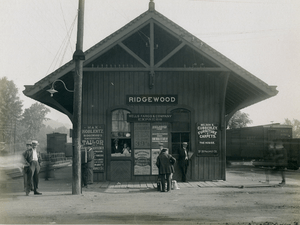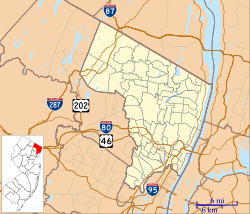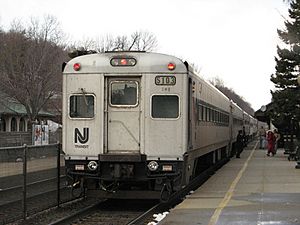Ridgewood station facts for kids
Quick facts for kids
Ridgewood
|
||||||||||||||||||
|---|---|---|---|---|---|---|---|---|---|---|---|---|---|---|---|---|---|---|

Ridgewood station in October 2014 from the Hoboken-bound platform.
|
||||||||||||||||||
| Coordinates | 40°58′51″N 74°07′14″W / 40.9807°N 74.1205°W | |||||||||||||||||
| Owned by | New Jersey Transit | |||||||||||||||||
| Platforms | 1 side platform, 1 island platform | |||||||||||||||||
| Tracks | 3 | |||||||||||||||||
| Connections | (all connections two blocks away at Van Neste Square; several of those routes have connections at the station on Godwin Avenue) |
|||||||||||||||||
| Construction | ||||||||||||||||||
| Parking | Yes | |||||||||||||||||
| Bicycle facilities | Yes | |||||||||||||||||
| Disabled access | Yes | |||||||||||||||||
| Other information | ||||||||||||||||||
| Station code | 2315 (Erie Railroad) | |||||||||||||||||
| Fare zone | 9 | |||||||||||||||||
| History | ||||||||||||||||||
| Opened | October 19, 1848 | |||||||||||||||||
| Rebuilt | 1859 August 1915–November 28, 1916 February 2009–September 2011 |
|||||||||||||||||
| Previous names | Godwinville (1848–1866) | |||||||||||||||||
| Traffic | ||||||||||||||||||
| Passengers (2012) | 1,433 (average weekday) | |||||||||||||||||
| Services | ||||||||||||||||||
|
||||||||||||||||||
|
||||||||||||||||||
|
Ridgewood Station
|
||||||||||||||||||

The former Ridgewood station prior to reconstruction.
|
||||||||||||||||||
| Location | Garber Square, Ridgewood, New Jersey | |||||||||||||||||
| Area | 5.5 acres (2.2 ha) | |||||||||||||||||
| Built | 1916 | |||||||||||||||||
| Architect | Drinker, W.W.; Howard, Frank A. | |||||||||||||||||
| Architectural style | Mission/Spanish Revival | |||||||||||||||||
| MPS | Operating Passenger Railroad Stations TR | |||||||||||||||||
| NRHP reference No. | 84002582 | |||||||||||||||||
| Significant dates | ||||||||||||||||||
| Added to NRHP | June 22, 1984 | |||||||||||||||||
Welcome to Ridgewood Station, a busy train stop in Ridgewood, New Jersey. This station is run by NJ Transit. It's a key spot where people can switch between different train lines.
Ridgewood Station has two main platforms. One is a side platform, and the other is an island platform. These platforms serve trains on the Main Line and the Bergen County Line.
Contents
Discovering Ridgewood Station's Past
Early Days of Train Travel
Trains first started stopping in the area, then called Godwinville, on October 19, 1848. This was when the Paterson and Ramapo Railroad opened. This new railroad connected Paterson to Suffern.
A new station building was put up in 1856, and another in 1859. Later, in August 1915, the Erie Railroad took over. They began building two fancy new station buildings in Ridgewood. These beautiful new stations opened on November 28, 1916.
A Historic Landmark
The Erie Railroad built the Ridgewood station in 1916. It was designed as an elevated station, meaning it was built above the street level. This helped trains and cars avoid crossing paths.
Today, Ridgewood station is a very important historical site. It has been listed on the New Jersey Register of Historic Places and the National Register of Historic Places since 1984. This means it's recognized for its special history and architecture.
Long-Distance Journeys from Ridgewood
For many years, until the 1960s, Ridgewood station was a hub for long-distance travel. Passengers could catch trains to faraway cities like Binghamton. From there, they could connect to trains heading to Chicago or Buffalo.
Famous trains like the Erie Limited and the Lake Cities passed through Ridgewood. These trains took passengers all the way to Chicago. The Atlantic Express brought passengers from the west to Ridgewood.
After the Erie Railroad merged with the Lackawanna Railroad, long-distance service slowly ended. The last long-distance trains stopped running through Ridgewood in the mid-1960s.
Modern Upgrades for Everyone
Between 2009 and 2011, Ridgewood station got a big makeover. The main goal was to make the station accessible for everyone. This was done to follow the Americans with Disabilities Act of 1990.
As part of these upgrades, high-level platforms were added. These platforms are at the same height as the train doors, making it easier to get on and off. The old side platform on Track 1 was removed. In its place, an island platform was built to serve both Tracks 1 and 3.
Ramps were installed on both platforms. Elevators were also added to help passengers get from the platforms down to the underpass on Franklin Avenue. These changes made the station much more user-friendly.
How Ridgewood Station Works
Understanding the Platforms
Ridgewood station has three main areas for trains. There's one side platform for trains heading towards Hoboken. There's also an island platform for trains going north. Most of these platforms are high-level. There's also an old low-level platform that isn't used anymore.
To get between the platforms, you can use underpasses. These are walkways that go beneath the train tracks. One underpass also goes under a bridge on Franklin Avenue.
| P Platform level |
Track 3 | ← Main Line and Bergen County Line toward Waldwick or Suffern (Ho-Ho-Kus) ← Port Jervis Line limited service toward Port Jervis (Ho-Ho-Kus) |
| Island platform, doors will open on the left or right | ||
| Track 1 | ← Main Line and Bergen County Line toward Waldwick or Suffern (Ho-Ho-Kus) ← Port Jervis Line limited service toward Port Jervis (Ho-Ho-Kus) |
|
| Track 2 | Port Jervis Line limited service toward Hoboken (Glen Rock – Main Line or Glen Rock – Boro Hall) → Bergen County Line toward Hoboken (Glen Rock – Boro Hall) → Main Line toward Hoboken (Glen Rock – Main Line) → |
|
| Side platform, doors will open on the right | ||
| G | Street level | Station building, ticket machines, parking |





